The Philodendron Strawberry Shake is a tropical sensation that’s sure to make your indoor jungle just a little bit sweeter.
With its stunning variegated leaves of green and creamy pink, this eye-catching plant is highly sought after by houseplant collectors due to its gorgeously colored leaves — a base of green with a mix of pink, cream, white, and deep red shades.
We’ll take a deep dive into everything you need to know about Philodendron Strawberry Shake care, covering its care requirements, growth habits, and more. If you’ve been dreaming of a shake-up to your plant collection, this beauty will undoubtedly hit the spot!
Table of Contents
Philodendron Strawberry Shake Plant Care Guide
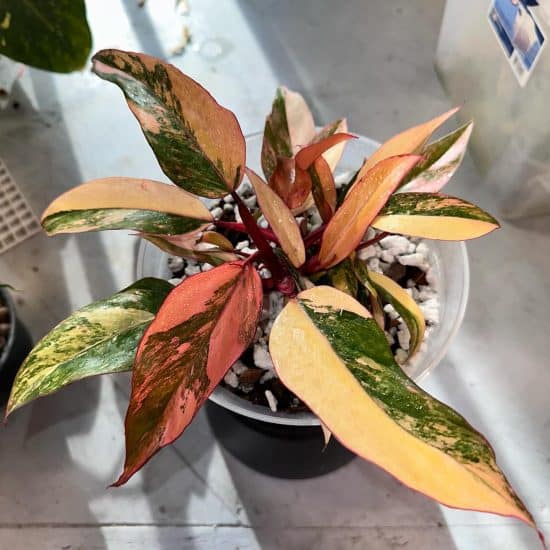
History, Habitat, and Characteristics
Philodendron Strawberry Shake (Philodendron erubescens ‘Strawberry Shake’) has vibrant, variegated leaves that look like artist’s creations.
Hailing from the tropical rainforests of South America, this leafy wonder isn’t your usual run-of-the-mill Philodendron. Horticulturists cultivated Philodendron Strawberry Shake from Philodendron erubescens ‘Red Emerald.’
So, what makes this plant the star of the show? The answer lies in its leaves. The Strawberry Shake’s young leaves emerge with a blush of pink (thanks, Philo erubescens!) that gradually fades to a lovely creamy white as they age.
Meanwhile, the green base color deepens, adding depth and contrast to the plant’s foliage. The ever-changing color palette can even include yellow and shades of red, making every new leaf a delightful surprise.
But wait, there’s more! The variegation of this gorgeous houseplant doesn’t follow a predictable pattern. Each leaf can sport different colors and patterns, making it a hot commodity among plant lovers.
Worried about taking care of this pretty-in-pink plant? No need. The Philodendron Strawberry Shake shares similar care requirements with its Philodendron cousins. Just make sure you give it the right dose of light (coming up next), or your plant might lose its colorful charm.
Fun fact: When bathed in bright indirect light, the Philodendron Strawberry Shake’s leaves can develop a mesmerizing shimmery iridescence. It’s like having a living rainbow in your home. Enjoy the show!
Light
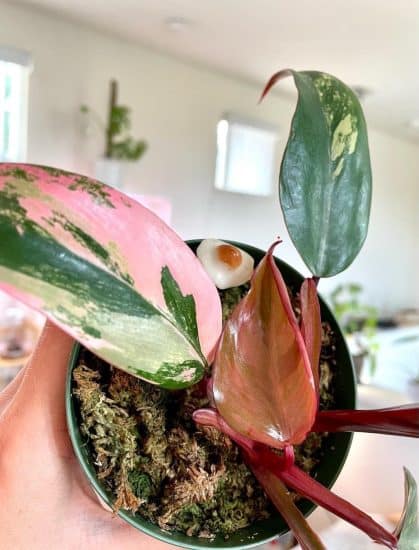
As a naturally occurring hybrid of a climbing plant native to tropical rainforests, Strawberry Shake Philodendron prefers bright indirect sunlight. To encourage optimal growth and stunning pink variegation, aim for bright light as close to 12 hours a day as you can get.
Consistency is key with Philodendron light requirements, especially variegated ones like the Strawberry Shake. Maintaining around 2,500 lux for 12 hours a day will help retain that eye-catching variegation we all love (by the way, using a light meter can be a game-changer for monitoring light levels).
If your Strawberry Shake Philodendron isn’t receiving enough light, you’ll notice a decrease in variegation, slow growth, and leggy stems stretching towards any source of brightness. Don’t panic! Simply adjust the plant’s location or consider adding an artificial light source to give it the boost it needs.
On the flip side, too much direct sunlight can also pose problems. An overexposed Strawberry Shake Philodendron may show signs of burned, discolored, or sun-bleached leaves.
To prevent this, try relocating your plant further away from the window, or even add a sheer curtain to filter the sunlight just right (remember, it’s all about balance).
Water
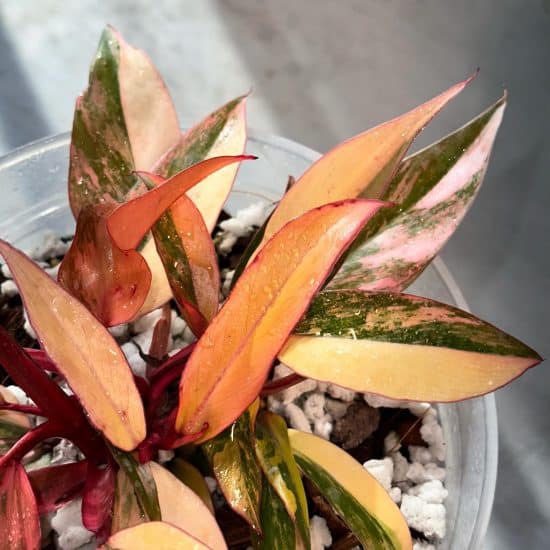
Maintaining adequate moisture levels without overwatering is key to keeping your Strawberry Shake Philodendron thriving.
Not receiving enough water can lead to some unhappy symptoms for your Strawberry Shake Philodendron plant. You might notice wilting, curling leaves, or dry brown spots on the colorful leaves. These are clear signs that your plant is thirsty and needs more frequent watering to bounce back.
On the other hand, too much water can be just as harmful to your Strawberry Shake. Overwatering often results in yellow leaves, mushy or rotting roots, and a plant struggling to thrive. It’s crucial to balance your watering schedule to prevent these issues from damaging your houseplant.
Our tips:
- To determine when your Strawberry Shake Philodendron needs water, rely on the finger test. If the top inches of soil feel dry for a day or two, it’s time to water. No moisture meter required!
- When watering, pour water from the top until it flows through the drainage holes. This practice prevents excess water from drowning roots.
- Keep a close eye on your plant for signs of underwatering, like wilting or curling leaves. Adjust your watering routine as needed to ensure a healthy, happy Strawberry Shake Philodendron.
- If you spot yellow leaves or mushy roots, overwatering might be the culprit. Let the soil dry out before watering again, and consider reducing your watering frequency to find the right balance for your plant.
Temperature and Humidity
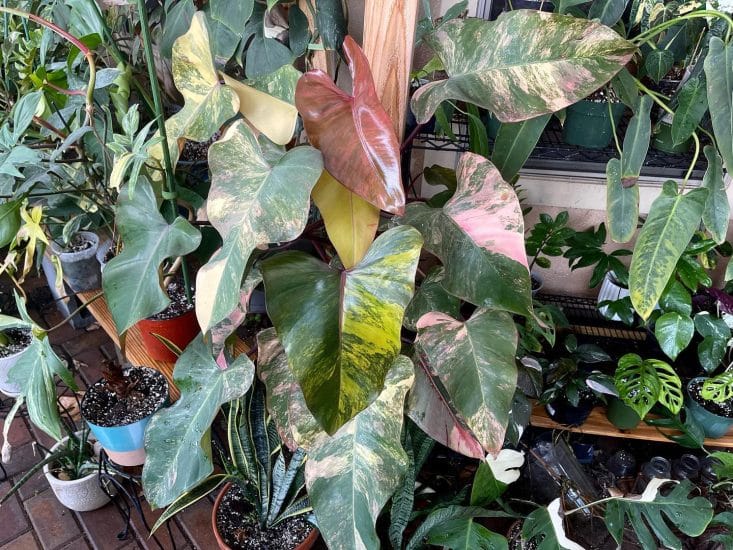
Temperature plays a significant role in the well-being of a Philodendron Strawberry Shake. As a native tropical plant, it prefers warmer temperatures between 65-80°F (18-27°C).
Be cautious of temperatures lower than 55°F (13°C) and cold drafts from windows, air conditioners, or doorways, as these can lead to Philodendron problems like stress and damage.
If you notice wilting, yellowing leaves, leaf drop, or stunted growth, it could be a sign that the plant isn’t happy with its temperature environment. Make adjustments by moving your Shake to a more suitable location, ideally with bright indirect sunlight.
Strawberry Shake Philodendrons thrive in humidity levels around 50%, which is similar to their native greenhouse and tropical habitat. This level of humidity encourages healthy growth and the strong root development.
Keep an eye out for signs of low humidity, such as brown leaf tips or edges, and high humidity problems like mold or rotting roots.
To raise humidity:
- Place your Strawberry Shake Philodendron on a pebble tray filled with water (make sure the plant’s pot doesn’t sit directly in the water).
- Use a humidifier in the same room as your plant to maintain high humidity.
- Group your Philodendron plant with other moisture-loving plants to create a higher humidity microclimate.
- Consider placing your plant in a naturally humid room, like the bathroom, as long as there is adequate light and good air circulation.
Though misting the leaves can help remove dust and potential Philodendron pests, it doesn’t provide long-term humidity control. If you choose to mist, ensure you wipe the leaves off afterward to prevent excess moisture.
Soil and Planting
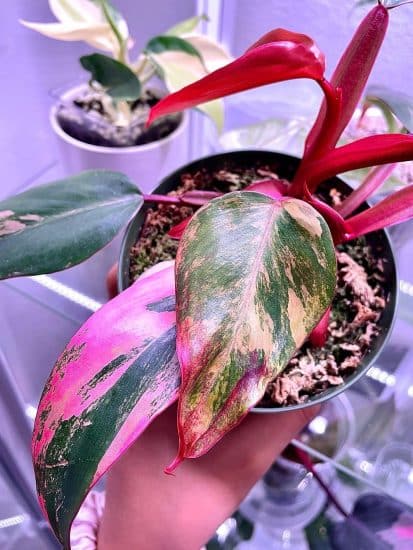
Strawberry Shake Philodendron can be grown in various mediums, like pond or LECA (Lightweight Expanded Clay Aggregate), sphagnum peat moss, orchid moss, fresh soil mix with perlite, vermiculite, and pumice.
These mediums all provide quick drainage and give the roots something to hold onto, promoting healthy growth in this rare and expensive plant.
When it comes to potting, using a high-quality tree fern soil with added organic matter is ideal for Strawberry Shake Philodendron. Ensure the pot has drainage holes to prevent waterlogging and provide well-draining soil.
For added support and encouraging upward growth, secure your Strawberry Shake Philodendron to a self-watering moss pole.
Fertilizing
For Strawberry Shake Philodendron fertilizer, opt for a liquid nutrient — like a 2-2-1 or 1-2-2 solution — and apply it sparingly, only every other watering session. Keep in mind: always water before you fertilize! (Trust me on this one).
If you notice any yellowing or burnt edges on the leaves, it might be a sign of over-fertilization. In this case, reduce the frequency of fertilization and flush the plant with water to remove excess nutrients.
Propagation
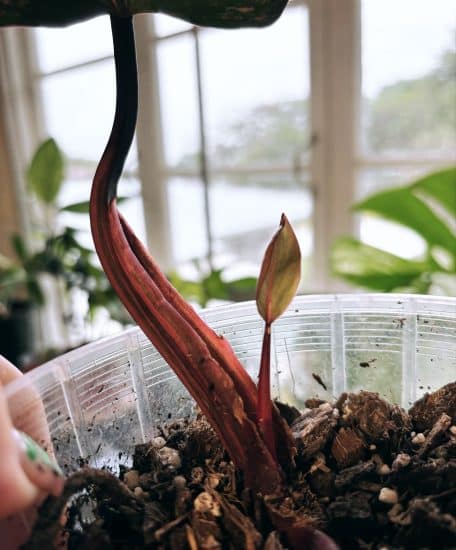
Strawberry Shake Philodendron propagation is fun and pretty easy to boot. By using the stem cutting method, you’ll be able to grow some beautiful new plants in no time.
Propagating Strawberry Shake Philodendron by stem cuttings:
- Choose a healthy plant with fresh roots and balanced variegation. Look at the mother plant and find a stem that has vibrant leaves and healthy roots. This way, your cutting starts off strong.
- Decide where to make the cut, ensuring there are at least one or two nodes present. Nodes are small bumps or rings found along the stem — they’re essential for successful propagation. Find a section of the stem with at least one or two nodes available for rooting and some healthy leaves above the nodes.
- Wipe the shears with alcohol before cutting. This helps prevent contamination and keeps your new cutting healthy. Sterilizing the shears ensures you eliminate any bacteria, fungi, or common pests that could damage your plant.
- Make a clean, precise cut and collect the cutting. Try to cut just below a node, making a diagonal cut to maximize the surface area for the stem to take up water and nutrients. Gently remove any lower leaves to expose at least one leaf’s node for rooting.
- Repeat the process for any additional cuttings desired. If you want more cuttings, follow these steps for each, always using clean and sterilized shears.
- Place the cuttings in water or LECA for propagation. Fill a container with water or LECA and put the cuttings with the exposed nodes submerged. Keep the container in bright, indirect light, and make sure the water or LECA stays clean and fresh. In a few weeks, new roots should develop from the submerged nodes.
Our propagation tips:
- Use the “chop and prop” method to quickly recover an ailing or reverted Strawberry Shake plant, since it’s fast-growing. Place the top cutting on a plant shelf with double grow lights (LED, ideally) to encourage more variegation.
- The best time to propagate is during the growing season, which is usually in spring or early summer. This way, the plant actively grows and can produce new roots more readily.
- Keep an eye on the water or LECA levels and ensure the cuttings are in bright, indirect light. Change the water every few days to prevent bacterial growth and maintain a healthy environment for your new Strawberry Shake Philodendron plants.
Common Issues
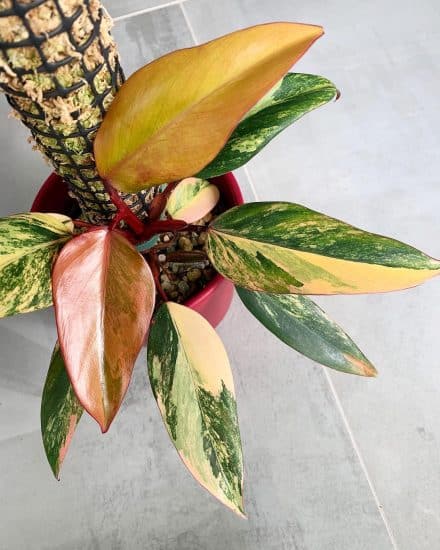
Philodendron Strawberry Shake is a stunning, rare plant that can encounter a couple of issues along the way.
Dry Roots
One issue you might find with your Strawberry Shake Philodendron is dry roots, which can compromise successful propagation or moss pole attachment. To keep them healthy and moist, check on the roots regularly, particularly during propagation.
Mist the roots with water, or enclose them in damp sphagnum moss to maintain humidity (both great options). If you spot any dried out roots, trim them carefully before attempting propagation or securing the plant to its support structure.
Difficulty Attaching to Moss Pole
At times, your Strawberry Shake Philodendron might struggle to attach to a moss pole, due to the pole’s thickness or the plant’s stiffness. To address this issue, select a moss pole of suitable thickness for your plant, ensuring it’s firmly anchored in the pot.
If you notice your plant grappling to attach, gently guide its roots towards the pole and wrap them around it, using soft plant ties or twine, if needed.
Adding a layer of damp sphagnum moss around the pole offers extra support, while encouraging a stronger grip from your Philodendron Strawberry Shake’s roots.
Pests and Diseases
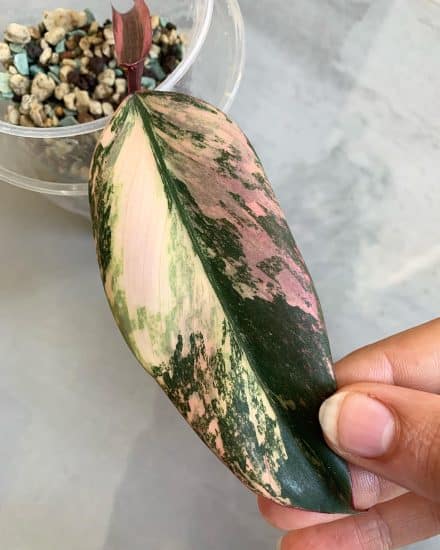
Strawberry Shake Philodendron diseases are fairly common, so luckily, they have common solutions as well (which makes for our favorite type of Philos: healthy plants!).
Pests
Good news — the Strawberry Shake Philodendron isn’t especially susceptible to pests. However, you should still monitor your plant’s health to catch potential invaders like aphids, mealybugs, or spider mites early on. Strawberry Shake Philodendron pests can be managed if caught in time.
If you notice tiny bugs hiding beneath leaves or small web-like structures, take action immediately. Spraying your plant with neem oil and wiping it with a damp cloth can help remove visible insects.
Keep a watchful eye on your plant for several weeks after treatment, ensuring the pests don’t come back.
Root Rot
Many indoor plants, including the Strawberry Shake Philodendron, can be affected by root rot. This issue arises when roots are left sitting in overly wet soil for too long, causing decay and damage.
To spot root rot, look for tell-tale signs like yellowing leaves, wilting, or a musty smell coming from moist soil.
Here’s what to do if you find root rot:
- Gently remove the plant from its pot and examine the roots. Trim away any brown, black, or mushy roots using sterilized scissors (to prevent spreading disease to healthy roots).
- Give the remaining healthy roots time to dry out for a few hours before repotting the plant in fresh, well-draining potting soil. Make sure the new pot has proper drainage holes to avoid future root rot issues.
- Water your Strawberry Shake Philodendron sparingly — only when the top few inches of soil are dry (to prevent overwatering).
Conclusion
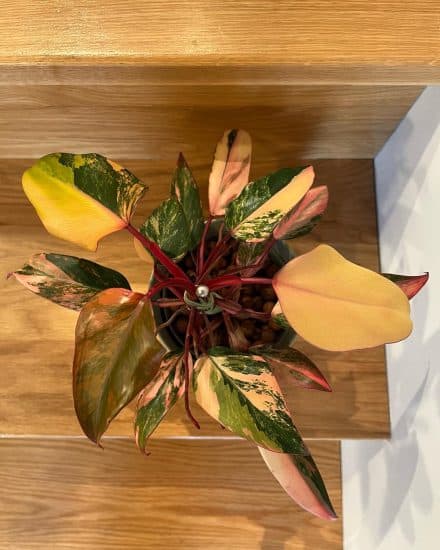
That’s a wrap for our Philodendron Strawberry Shake care guide!
With its unmistakable variegated leaves and charming personality, this hybrid beauty can be the highlight of any indoor space. By following the tips and techniques shared in this guide, you’ll be well on your way to nurturing a stunning, healthy Philodendron Strawberry Shake at home.
Philodendron Strawberry Shake care summary:
- Provide bright, indirect light to maintain vibrant variegation and promote healthy growth.
- Water properly to maintain adequate moisture levels and avoid underwatering or overwatering.
- Monitor temperature and humidity to create a comfortable environment for your plant.
- Choose the right soil and potting medium for optimal growth and support.
- Propagate using stem cuttings for an exciting and rewarding experience.
- Keep an eye on common issues, such as pests and root rot, to ensure your plant remains vibrant and problem-free.
We hope this comprehensive guide has equipped you with everything you need to know about Strawberry Shake Philodendron care.
If you found this article helpful, feel free to share it with fellow plant enthusiasts, and don’t hesitate to reach out if you have further questions. Now it’s time to shake things up and let your new Strawberry Shake plant flourish!
Happy growing!
FAQ
Is Philodendron Strawberry Shake rare?
As of this writing, yes, but every time someone purchases one, it becomes less scarce. It’s unsurprising that Strawberry Shake Philodendron is rare now because it’s an absolutely gorgeous hybrid cultivar that’s relatively new to the scene.
Why is Philodendron Strawberry Shake so expensive?
Philodendron Strawberry Shake is is pricey because it’s a rare cultivar and also in high demand. Those two qualities are a perfect storm for creating expensive plants.
What kind of philodendron is a Strawberry Shake?
Strawberry Shake Philodendron is a hybrid cultivar of Philodendron erubescens, specifically ‘Red Emerald.’
Is Strawberry Shake Philodendron toxic to humans?
Yes. Since it produces calcium oxalate crystals, like other Philodendrons, Strawberry Shake is toxic to humans and animals. Best to keep it out of the way of tiny paws and hands!


